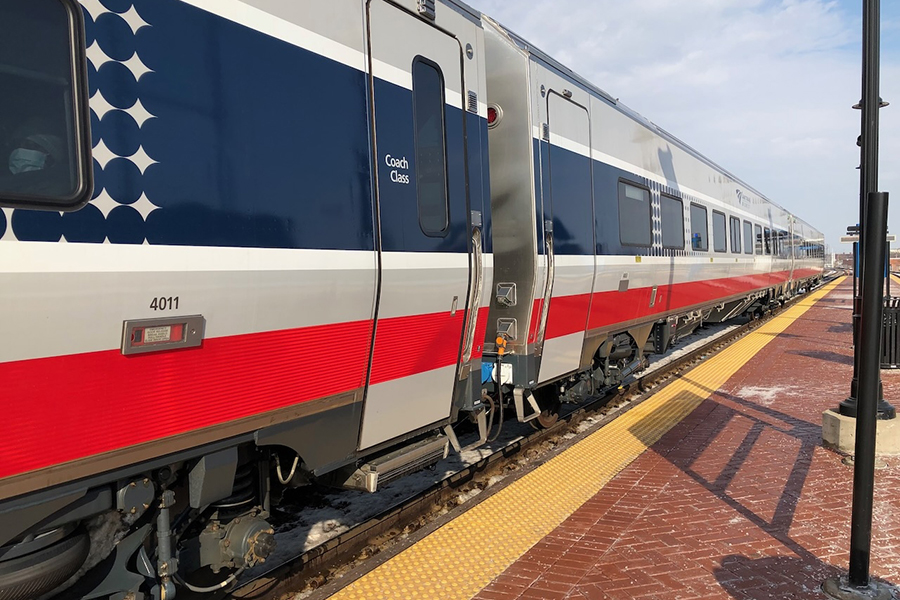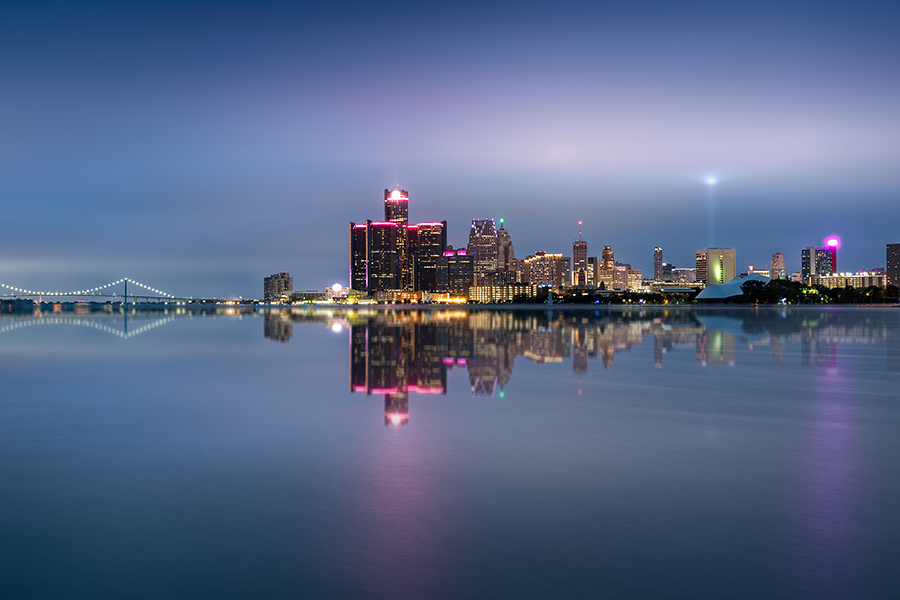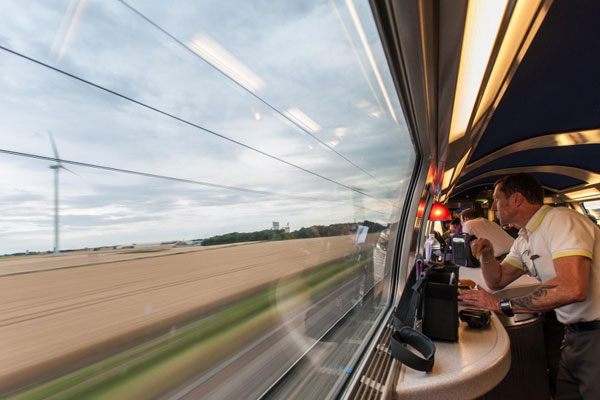Chris Koos began serving on the Normal (IL) city council in 2001 and has been the town’s mayor since 2003. With the support of the council and Mayor Koos—and the work of a wide-ranging alliance of civic and business champions—Normal has transformed its downtown by investing in trains and other sustainable transportation modes over the past two decades. The cornerstone of the reinvention is a $47 million, multimodal train station in the heart of Normal—about 130 miles southwest of Chicago—on Amtrak’s Lincoln Service line from Chicago to St. Louis. The station, which opened in 2012, is the second busiest in Illinois and is heavily used by the roughly 21,000 students at nearby Illinois State University.
Mayor Koos was nominated for Amtrak’s board of directors by President Donald Trump in 2020. He was renominated by President Joe Biden in 2022. Sen. Jon Tester (D-MT) has blocked the confirmation of Biden’s board nominees because the slate fails to meet diversity requirements (in terms of geographical representation) set by Congress. On October 11, the Biden administration announced that it would withdrawal one of the nominees from the Northeast Corridor. Biden is expected to nominate a new candidate from a Western state, and Tester is expected to lift the blockade on the nominees. “I’m pleased to see that the Biden Administration will follow the law and set up an opportunity to do right for rural America by guaranteeing our Amtrak board represents our nation’s diverse geography,” Sen. Tester said.
In early October, Mayor Koos talked with the High Speed Rail Alliance about trains and their role in Normal’s reinvention. Find our related blog post about Normal here and part 2 of the HSRA interview here. Both interviews have been edited for length and clarity.
HSRA: You’ve mentioned that it tends to be under-appreciated how vital trains are to the life of smaller towns and cities.
Koos: Passenger rail serves a lot of people for day trips or overnight trips—primarily in and out of Chicago, for us, although there is traffic to Springfield and St. Louis as well. A lot of Illinois State University students come from the Chicagoland area, so they use it to go home for a weekend. There are a lot of short trips on long-distance routes like that.
You’ve also said that there’s a lot of emphasis on speed, but that frequency is just as important.
Frequency and on-time arrival are more important than speed, especially for the business traveler. The ability to get to a destination in a timely manner—in a reliably timely manner—makes a big difference for their decision to use trains. And frequency makes a big difference, too. We have people that will go to Chicago for the day and come back, whether it’s for shopping or a Cubs game or something like that. That’s pretty important. But probably the most important is on-time performance.
We just talked about frequency and reliability as maybe more important than speed. But do you have any thoughts on the new 110-mile-per-hour service?
On the Chicago-St. Louis line, it seems to be pretty flawless in its implementation. You almost don’t notice that you’re going that much faster. It’s a very smooth, dependable ride. And all of a sudden you realize, wow, we’re passing cars on the highway. I think it helps. There’s no question that—when you can knock a half hour off of your trip—that makes a big difference and gives train travel a stronger advantage.
Is there anything you’d like to see changed?
There was some talk prior to the Great Recession of adding one, maybe two more trains a day. We’ve got a hole in the afternoon schedule that people are concerned about. I think the last train leaves about 7 p.m. from Chicago. A lot of people say they wish there was a later one so they could do a theater or a dinner in Chicago, get on a train, and come back.
Can you comment on how the redevelopment and the rebuilding of downtown Normal around the train station has shaped the life of the community?
Our Marriott Hotel is a conference hotel. That has been a calling card for them—to say that you can take the train here from St. Louis or Chicago and walk kitty-corner from the train station to the hotel. Because of the compact nature of our Uptown area, you can be here for a three-day conference and never touch a car.
In the early years or maybe in the planning stages, the plan to reinvent Normal’s downtown was a little bit contentious, right?
I was at a mayor’s conference recently and somebody made a comment that I found humorous, which was: The only person that wants change is a baby with a wet diaper. People are kind of skeptical about what things will be. But we reached a turning point, I think, when the [Marriott] hotel got built [in 2009]. People saw that this was going to be a transformational development area. And transportation has had a lot to do with it. People have certainly warmed up to using the train more, because it’s an easy-to-access station. It’s modern and clean. And people put a high value on that.
Do you remember what the source of the pushback was in the early years? What were people afraid of?
Probably the pushback was the amount of local bonding. We did a fair amount of land acquisition, strategic land acquisition, to redo the Uptown area. We did a significant amount of infrastructure. We were looking at an area that had over 100-year-old water and sewer systems. And we thought, if we’re going to do this, let’s do it bottom up and replace all that. And then we had some projects that, with the TIF that we had in the area, helped to finance what we considered a better, more appropriate project for what we were trying to do.
With a project of this magnitude, it’s not just one person behind it. It’s an alliance of people. Where did the energy come from?
Well, the city council, at the time we started, had the vision to do this. I wasn’t even on council when this happened. The city manager went to the council and said, ‘What do you want to do? Do you want to modernize the street lighting and clean everything up a little bit? Or do you want to do something a little bolder?’ Well, I don’t think anybody had any idea how bold we were going to get.
Do you know what models they were looking to?
We looked at Gainesville, Florida and Tempe, Arizona as models. We looked at Oxford, Ohio, where Miami of Ohio [University] is. Communities like that, that had started, or had completed, that kind of transit-oriented development around the university. We specifically looked at university communities as much as possible, and we learned a lot from them. We heard from people in Washington, when we were getting federal dollars—they said, ‘This is a very, very, very solid plan. We don’t often see plans this good.’ That was also one of the early controversies. We spent a fair amount of money getting the right consultants and planners to come in and really do this right.
Has anything about the way it’s developed surprised you, or been different than you imagined it would be?
We’ve had our share of setbacks in terms of the recession, COVID, things like that. We had plans for some really interesting buildings on the other side of the circle. There was going to be a lot of office and retail and some residential development. COVID turned that upside down, and we had to rethink that.
Do you feel like you’ve reached a point where the development is creating a virtuous cycle?
It really has. There’s a lot of interest. We’re doing an underpass to get under the tracks, because we have eight acres of land on the other side of the tracks that are prime for development. There’s a huge need for residential construction in this community.
Between Bloomington and Normal, we’re about 8,000 units short on housing. A lot of that has to do with the new manufacturing that’s coming into the community, especially Rivian [car] and Ferrero [chocolate] manufacturing. We have just now gotten the dollars that we need to do the underpass project. We’re finishing up construction drawings, and we’ll go to bid as soon as we’re done doing that. We’re hoping to be under construction on that underpass in the spring. We felt like there were two things that we could do with that piece of ground, and that would be to develop it completely separate from the Uptown, because there’s no easy access for that, or tie it into the Uptown. The majority of the council wanted to tie it into the Uptown via an underpass. We’re doing it in such a way that it’s not what a lot of people would see as an underpass—a narrow box tunnel that goes through. It’ll be 20-some feet wide, 10 feet tall, 80 feet long, and very well lit. We have a park-like setting here that we’re going to adjust a little bit on this side, and do another one on the other side. It becomes more of a gathering place, as much as a transportation asset.
But it’s not clear how the land will be developed?
No. I think our sense is that developers are waiting to see what’s going to happen. Once it goes under construction, I think we’ll see some development interest. In terms of commercial development—whether it’s multifamily, retail, or office, or anything like that—banks are very nervous about lending right now, and developers are being very cautious.
You’ve been nominated to be a member of the Amtrak board. If and when that goes through, what priorities do you want to advance?
Probably three or four different priorities. It’s like being a mayor of a city. You’ve got basics you’ve got to get done and stay on top of. Safety is a huge, huge issue. Not that they’re having a problem, but it needs to be at the forefront.
Safety in terms of?
Rail accidents. Mostly rail accidents and employee injuries, as a result of the work that they do, would be very high on the list. Also, this is something that COVID did—hiring and training a new generation of workers for Amtrak is going to be a huge issue. The skills required to maintain the equipment are high. To take somebody and hire them, I’ve been told—it’s about a two-year training process for them to really get up to speed in terms of actual physical work on the rolling stock. Training new conductors and people on the trains takes some time. That’s important.
The third one would be long-distance trains. These trains are vital to the heartland of the United States in terms of a transportation alternative.
You’d like to see more routes or more frequency on the routes?
I would like to see more routes. There are communities that it makes sense to connect. Cincinnati to Cleveland, to Dayton, to Columbus. There are corridors like that. There are corridors in Oklahoma and Texas that make a lot of sense. Another one is Indiana. Why there isn’t better service between Indianapolis and Chicago is kind of a mystery.
Learn More
The Chicago - St. Louis Corridor
The Chicago – St. Louis Corridor Project is paying big dividends.
The Chicago – Detroit Wolverine Corridor
The Michigan Department of Transportation (MDOT) is taking slow and steady steps towards modern service. Expediting the work, with a goal of hourly departures, would create vital links among some of the state’s most vibrant cities.
Illinois needs an integrated rail plan
There is a golden opportunity to restore Michigan Central as a working train station—and turn Detroit into the heart of a hotbed of high-tech innovation.




